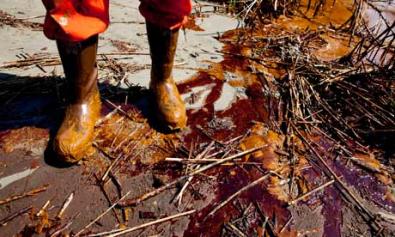
Atlantic coast now under threat as current spreads Gulf oil slick Scale of disaster apparent as no-fishing zone doubles and controversial dispersant is used
Suzanne Goldenberg
On the island of Key West, south of Florida, coastguard officials said about three tar balls an hour were washing up on the beaches of a state park. They said the globs of concentrated oil suggest leaking crude has now become caught up in the powerful loop current and could move from the gulf up to the Atlantic coast.
Meanwhile, an oceanographic research ship reported sighting a 10km (six-mile) plume lurking at depths below 1,000 metres and invisible from the surface.
The evidence of spreading environmental damage grew even more compelling with the release of fresh video showing thick clouds of oil billowing from the ruptured well.
The Obama administration responded by doubling the no-fishing zone to 19% of the waters in the gulf.
Fighting the spill is risky. Lisa Jackson, head of the Environmental Protection Agency, acknowledged that authorities were relying heavily on Corexit, a chemical banned in the UK because of its effects on limpets and other sea life.
"There has been a real reliance on them, maybe more than anybody thought would ever happen," she told the Senate environment and public works committee.
The mounting evidence forced administration officials to admit for the first time yesterday that they had underestimated the risks of offshore drilling.
In two highly charged hearings in the Senate, Ken Salazar, the interior secretary, conceded there had been failures in oversight by the agency responsible for policing offshore drilling. "We need to clean up that house," he said.
The Minerals Management Service (MMS), the regulatory body for offshore drilling, was notorious in the George Bush era for sex-and-cocaine fuelled parties in Colorado.
Salazar, under heated questioning from some senators, was forced to concede that the agency had not been entirely cleansed in the 15 months under his charge. "We need to have the right regulatory regime in place and we will work hard to make sure that happens," he said.
He admitted that the disaster had been a "wake-up call" and had persuaded him that policing of safety and environmental regulations on offshore oil rigs may have been inadequate. "My initial read on that is there should be additional safety requirements," he told the committee.
Salazar also conceded there were "a few bad apples" among the inspectors of the MMS, and promised that if they over-ruled environmental advice from other government agencies – as was alleged by some senators – they would be punished. "If there is someone in the department who ignored the science, then heads will roll," he said.
But Nancy Sutley, the chair of the White House council on environmental quality, told a Senate hearing later yesterday she had raised concern in February about a widespread policy of waiving environmental reviews for offshore drilling.
Salazar was also adamant that the administration had been right to seek an expansion of offshore drilling last March, and made it clear there would be no revisiting that decision.
The White House this week intensified its efforts to limit the potential political damage on November's mid-term elections by backing an independent commission to investigate the disaster. In testimony yesterday defensive actions also included dogged resistance by administration officials to senators' demands to provide estimates of the size of the spill.
The stonewalling went beyond the Senate hearings. For the past 48 hours, officials have resisted reports by scientists that the spill could have entered the loop current, or downplayed their significance. "By the time the oil is in the loop current, it's likely to be very, very diluted. And so it's not likely to have a very significant impact. It sounds scarier than it is," said Jane Lubchenco, the head of the National Oceanic and Atmospheric Agency.

